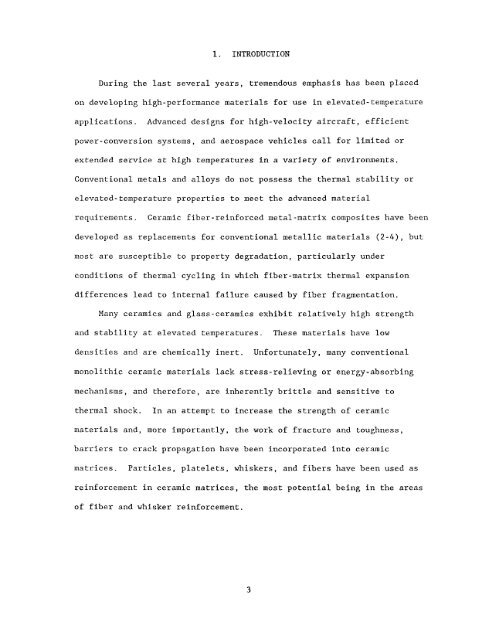Characterization and control of the fiber-matrix interface in ceramic ...
Characterization and control of the fiber-matrix interface in ceramic ...
Characterization and control of the fiber-matrix interface in ceramic ...
You also want an ePaper? Increase the reach of your titles
YUMPU automatically turns print PDFs into web optimized ePapers that Google loves.
1. INTRODUCTION<br />
Dur<strong>in</strong>g <strong>the</strong> last several years, tremendous emphasis has been placed<br />
on develop<strong>in</strong>g high-performance materials for use <strong>in</strong> elevated-temperature<br />
applications. Advanced designs for high-velocity aircraft, efficient<br />
power-conversion systems, <strong>and</strong> aerospace vehicles call for limited or<br />
extended service at high temperatures <strong>in</strong> a variety <strong>of</strong> environments.<br />
Conventional metals <strong>and</strong> alloys do not possess <strong>the</strong> <strong>the</strong>rmal stability or<br />
elevated-temperature properties to meet <strong>the</strong> advanced material<br />
requirements. Ceramic <strong>fiber</strong>-re<strong>in</strong>forced metal-<strong>matrix</strong> composites have been<br />
developed as replacements for conventional metallic materials (2-4), but<br />
most a:-e susceptible to property degradation, particularly under<br />
conditions <strong>of</strong> <strong>the</strong>rmal cycl<strong>in</strong>g <strong>in</strong> which <strong>fiber</strong>-<strong>matrix</strong> <strong>the</strong>rmal expansion<br />
differences lead to <strong>in</strong>ternal failure caused by <strong>fiber</strong> fragmentation.<br />
Many <strong>ceramic</strong>s <strong>and</strong> glass-<strong>ceramic</strong>s exhibit relatively high strength<br />
<strong>and</strong> stability at elevated temperatures. These materials have low<br />
densities <strong>and</strong> are chemically <strong>in</strong>ert. Unfortunately, many conventional<br />
monolithic <strong>ceramic</strong> materials lack stress-reliev<strong>in</strong>g or energy-absorb<strong>in</strong>g<br />
mechanisms, <strong>and</strong> <strong>the</strong>refore, are <strong>in</strong>herently brittle <strong>and</strong> sensitive to<br />
<strong>the</strong>rmal shock. In an attempt to <strong>in</strong>crease <strong>the</strong> strength <strong>of</strong> <strong>ceramic</strong><br />
materials <strong>and</strong>, more importantly, <strong>the</strong> work <strong>of</strong> fracture <strong>and</strong> toughness,<br />
barriers to crack propagation have been <strong>in</strong>corporated <strong>in</strong>to <strong>ceramic</strong><br />
matrices. Particles, platelets, whiskers, <strong>and</strong> <strong>fiber</strong>s have been used as<br />
re<strong>in</strong>forcement <strong>in</strong> <strong>ceramic</strong> matrices, <strong>the</strong> most potential be<strong>in</strong>g <strong>in</strong> <strong>the</strong> areas<br />
<strong>of</strong> <strong>fiber</strong> <strong>and</strong> whisker re<strong>in</strong>forcement.<br />
3

















